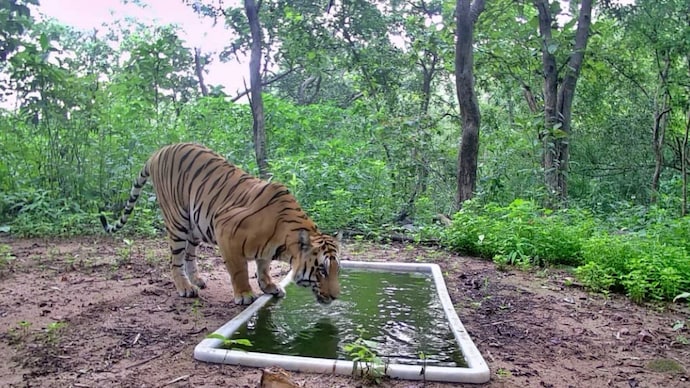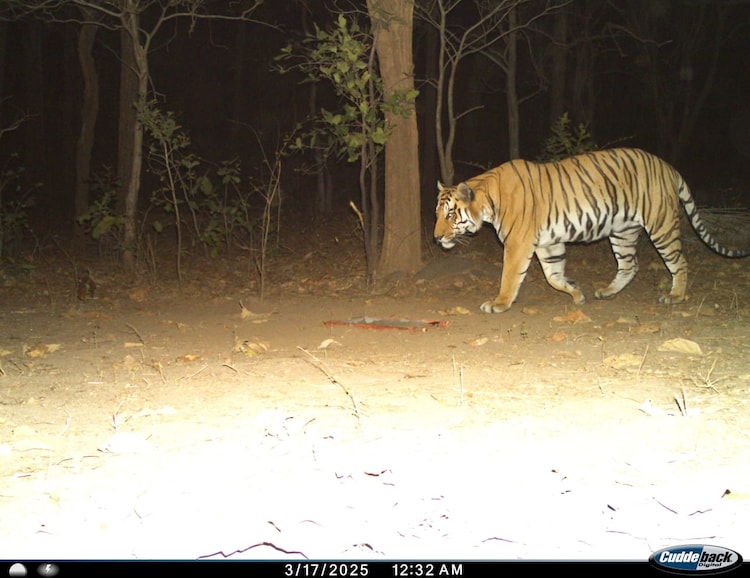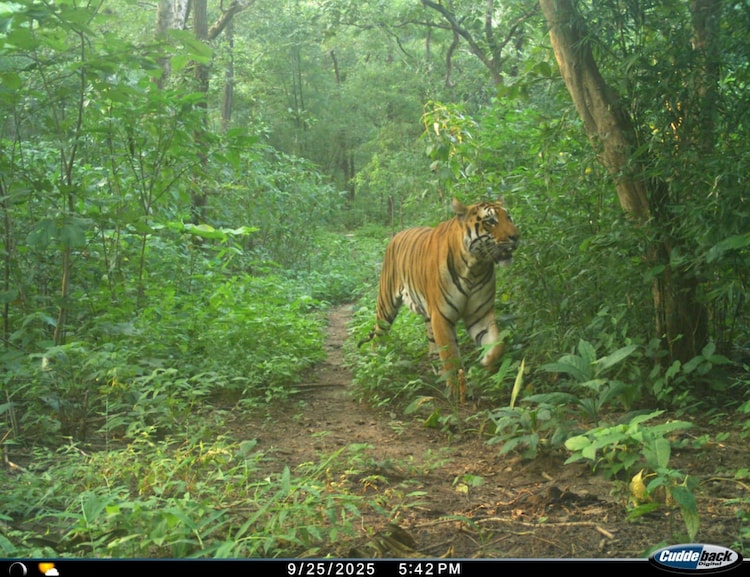 |
| The tiger that had entered Gujarat from Madhya Pradesh drinking from an artificial waterhole. |
In the early months of 2025, an unexpected chapter began unfolding in the wild heart of Gujarat. For the first time in nearly three decades, the unmistakable presence of a tiger— a young, five-year-old male—was captured on camera. Having journeyed from the forests of neighbouring Madhya Pradesh, the solitary cat was first glimpsed moving quietly along the edges of the Ratanmahal Wildlife Sanctuary in Dahod district. What followed was months of careful observation. Forest officials tracked his silent patrols, his shifting routes, and his growing confidence in the unfamiliar terrain. Now, nine months on, they have confirmed what few dared to imagine: the tiger has settled. Ratanmahal, after 32 long years, once again hosts a resident big cat. The announcement has been hailed as a milestone for conservation. Gujarat’s Forest Minister, Arjun Modhwadia, called it a moment of immense pride—proof that the state’s patchwork of ecosystems is robust enough to welcome back one of India’s most demanding predators. Wildlife experts, too, have underscored the significance of this return, highlighting the success of the ecological corridors that link Gujarat with Madhya Pradesh. With the tiger now staking his claim in this landscape, the challenge turns to the future. Conservation teams are working to ensure a healthy prey base and secure habitat—essential ingredients for the long-term survival of this remarkable new resident.
 |
| Camera trap footage showing the tiger. |
The tiger’s official return to Gujarat casts a revealing light on the quiet, painstaking work of conservation—on the wildlife corridors that stitch together fragmented habitats and allow long-lost species to reclaim their former territories. Once, tigers roamed freely from the northern reaches of Gujarat to its southern forests. But by the early 2000s, the species had vanished from the state, declared locally extinct after decades of decline. Then, in 2019, came a fleeting sign of hope: a lone tiger, having crossed into Mahisagar district from Rajasthan, was recorded within Gujarat’s borders. Its life, however, was tragically short—found dead only two weeks later, its promise unrealised. Now, six years on, a new chapter has begun. Another tiger has not only entered Gujarat but chosen to remain, settling into the landscape as if reclaiming a birthright. The news has stirred a sense of cautious optimism across the conservation community. With this remarkable return, Gujarat once again stands as a stronghold for all three of India’s iconic big cats: the Asiatic lion, the leopard, and now, once more, the tiger.
 |
| Another camera footage showing the tiger. |
While safeguarding the future of this lone tiger is undeniably vital, its presence also signals a broader responsibility: to prepare Gujarat’s landscapes for the arrival of others that may follow. That effort begins with the careful mapping of wildlife corridors—natural pathways linking Gujarat with Rajasthan, Madhya Pradesh, and Maharashtra. Each corridor must be studied in detail, its reach traced, its connection to protected areas understood, for these routes form the lifelines that allow wide-ranging predators to move safely across the subcontinent.Within Ratanmahal and its neighbouring forests, a modest prey base already exists—four-horned antelope (chousingha), muntjac (barking deer), and wild boar. Though all are part of the tiger’s natural diet, they alone cannot support a stable population. Elsewhere in India, the tiger relies heavily on chital (spotted deer), sambar, and the mighty gaur (Indian bison)—species once common across North and South Gujarat, now lost to history. Restoring these animals to their former ranges would not only strengthen the prey density needed for tigers to thrive, but would also rejuvenate the ecological balance of the region’s forests.
 |
| Ratanmahal Wildlife Sanctuary |
Equally important is the human dimension. Effective conservation depends on informed and engaged communities. Public awareness initiatives can help local villagers understand the ecological value of tigers and their prey, while equipping them with practical ways to reduce conflict and coexist safely with wildlife. The return of the tiger to Gujarat is more than an isolated triumph—it is a reminder of what remains possible. It offers renewed hope for the state’s wildlife, and for the long-term vitality of the forests that sustain them.
No comments:
Post a Comment